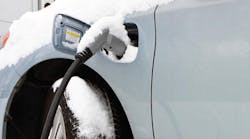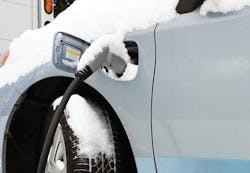Here’s something you probably know: Lowering temperature causes chemical reactions to proceed more slowly; therefore, if a battery is used at a low temperature, less current is produced than at a higher temperature. And if the temperature is low enough, the battery (or batteries as the case may be), can’t provide the necessary current. This holds true whether the battery chemistry is lead acid or lithium.
However, you may not know how drastically an EV’s range suffers in cold weather, such as was endured this winter in the Midwestern U.S. Because of the so-called polar vortex, weather pundits in Chicago were referring to the Windy City as “Chi-beria.”
AAA recently studied the effects of cold on EV range and found that when temperatures dropped to 20°F, EV range dropped an average of 41% compared to range measured at 75°F.
Heat also can influence driving range. AAA’s research found that when outside temperature heats up to 95°F and air conditioning is used inside the vehicle, driving range decreases by 17%. Extreme temperatures by itself plays a role in diminishing driving range, but the use of HVAC in these conditions, especially in the heat, has the greater effect.
What’s more, since an electric vehicle with a compromised driving range will require charging more often, that alone increases the cost to operate the vehicle. For instance, AAA’s study found that the use of heat when it’s 20°F outside adds almost $25 more for every 1,000 miles when compared to the cost of combined urban and highway driving at 75°F.
AAA tested five electric vehicles, all with a minimum EPA estimated driving range of 100 miles, in partnership with the Automotive Club of Southern California’s Automotive Research Center. For this study, AAA researchers used a 2018 BMWi3, a 2018 Chevrolet Bolt, a 2018 Nissan Leaf, a 2017 Tesla Model S 75D, and a 2017 Volkswagen e-Golf.
Five different EV models were tested at 20 and 95°F. (Source: AAA)
The BMW i3 was most sensitive to temperature change in both hot and cold conditions, losing 50% and 21% of range in cold and hot conditions, respectively. The Nissan Leaf was the most temperature-resistant, losing 31% and 11% of range in cold and hot conditions, respectively.
Test Conditions
Real-world driving conditions were simulated using a dynamometer in a closed testing cell where ambient temperature could be closely controlled. To determine the effects on driving range, scenarios for cold and hot weather conditions—both when using HVAC and not—were compared to those of driving with an outside temperature of 75°F.
All vehicles were procured and inspected to determine suitability for dynamometer testing according to the following criteria originating from SAE J1634: Checking that the odometer reading is between 1,000 and 6,200 miles. In addition, verifying that the battery ampere-hour capacity is within acceptable limits before and after testing, and verifying that no warning lights were illuminated at any point before or during testing.
The AAA report points out that driving range and MPGe estimates published on the Monroney sticker of all new EVs are typically calculated with respect to an ambient temperature ranging between 20 to 30°C (68 to 86°F). The standard test procedure utilized by the EPA is derived from SAE J1634. It currently consists of four Urban Dynamometer Driving Schedule (UDDS) cycles and two Highway Fuel Economy Driving Schedule (HWFET) cycles in a specified sequence including mid-test and end-of-test constant speed cycles (CSCs). The CSCs serve as a rapid “depletion phase”; these phases are usually run at 65 mph for a duration dependent on the vehicle’s battery capacity.
According to AAA, all test vehicles were evaluated at three temperatures because traction battery packs must operate under a wide range of ambient temperatures. Ironically, at low temperatures, Li-ion battery packs are less efficient due to increased heat generation. As temperature decreases, diffusion, conductivity and reaction rates decrease, which leads to increased voltage perturbation and heat generation.
Testing was initiated within one hour of the vehicle being removed from charge. Each test vehicle was allowed to fully charge at the tested temperature before moving on to the next test temperature. Once a vehicle finished charging and it was time to change test temperatures, the vehicle was soaked for a minimum of four hours after the test cell stabilized at the new test temperature. Then a new road-load derivation was carried out and preconditioning cycles were run until the battery was depleted.
Results Reveal…
The AAA study found that the additional heat generation represents a waste of useful energy, which is manifested as reduced driving range and equivalent fuel economy. Furthermore, depending on the ambient temperature and the specific architecture of the battery thermal-management system, energy may be expended to heat the traction battery via resistive heating.
At elevated temperatures, liquid or passive air cooling may be utilized to keep the traction battery at an acceptable temperature. This can also result in reduced driving range because liquid cooling requires energy that could otherwise be used to propel the vehicle. Aggressive driving will result in higher rates of heat generation, too, consequently increasing traction battery cooling demands.
In conclusion, “the research clearly shows that electric vehicles thrive in more moderate climates, except the reality is most Americans live in an area where temperature fluctuates,” said Megan McKernan, manager of Automotive Club of Southern California’s Automotive Research Center. “Automakers are continually making advances to improve range, but with this information, drivers will be more aware of the impacts varying weather conditions can have on their electric vehicles.”


